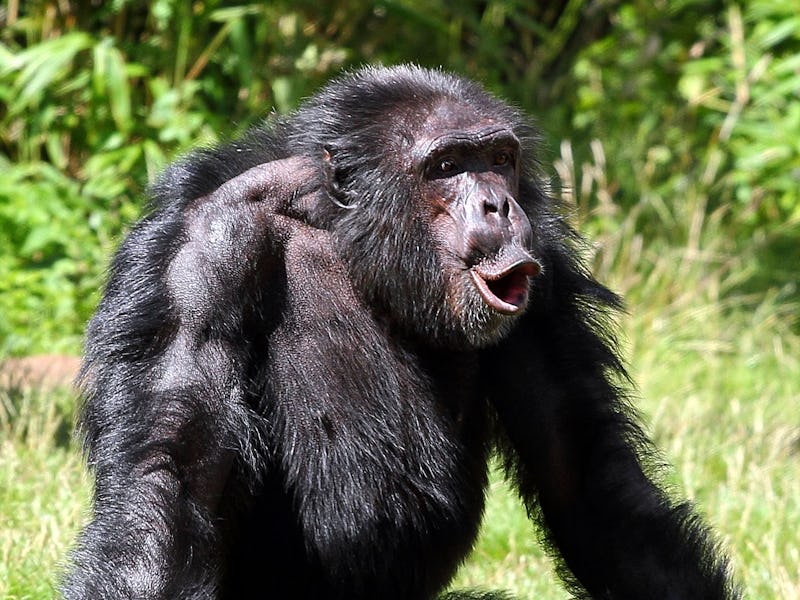Roots of Universal Communication System Revealed in Great Ape Study
'We think that in principle great apes could be able to understand one another.'

One of the reasons we find videos of great apes so compelling is because their behavior seems so much like ours. Though we can’t definitively say that a frantically pointing chimp experiences panic in the same way we do, or that his poop-throwing sibling feels anything akin to human irritability, we understand that these gestures are meant to convey a point to others.
Which is remarkable, considering we’re not chimps. Though we’re part of the same great ape family, the distinct differences between our genetics and culture prevent us, for the most part, from communicating with one another. But that may not always have been the case, write scientists in a new paper in Nature Ecology and Evolution. In their paper, published Tuesday, the researchers catalog a series of shared gestures and meanings between chimps and bonobos, our next-closest genetic relatives, suggesting that all great apes were able to communicate with each other at one point in time.
“[We] think that in principle great apes could be able to understand one another,” University of York psychology research associate and lead author Kristy Graham, Ph.D., tells Inverse by e-mail. Though she won’t call the shared gestures between bonobos and chimps a “language” per se because they can’t be used in a way that involves complex syntax, like human language, her research indicates that they may be remnants of a communication system universally shared among great apes.
Scientists have long known that chimpanzees use gestures to communicate, and in previous research, Graham and her co-authors, Catherine Hobaiter, Ph.D., and Richard Byrne, Ph.D., had discovered that many chimp gestures overlapped with those of bonobos, chimps’ closest living relatives. What they didn’t know then was that chimps and bonobos used the same gestures to convey the same meanings.
“[This] is the first study demonstrating that the meanings of the gestures are also largely shared,” Graham says.
The team began by building a “bonobo dictionary” by watching bonobos performing gestures and then observing the reaction the gesture elicited in another bonobo. If the gesturing bonobo was satisfied with that reaction, they reasoned, then the gesture’s meaning was conveyed correctly. So, for example, the gesture in the following video is thought to convey the meaning “climb on me” because the bonobo who gestured stopped doing so once the second bonobo climbed onto its back.
After defining 33 bonobo gestures in total (including “present genitals backward” and “present genitals forward”; they’re all cataloged in video form in the Great Ape Dictionary), the team compared the meanings with those of chimpanzee gestures, which were defined previously. Just as they thought, many of the gestures could be performed by both bonobos and chimps without losing anything in translation.
This is especially remarkable in light of the fact that bonobos and chimps diverged on the great ape tree some 1-2 million years ago. That’s plenty of time for a communication system to diverge, so the fact that some element of the system remained throughout the years suggested to Graham that the gestures might have biological underpinnings.
“We are always looking for the simplest explanation for behaviour, and the large overlap in gestures and meanings between individuals, groups, and species might suggest that gestures are biologically inherited,” she says. While human language, for the most part, is passed down through culture, Graham notes that among great apes it would be a “more complicated explanation if all of the gestures were learned but still meant the same thing for individuals in completely different groups and species.”
Follow-up studies on other great apes will determine whether gorillas, who use 60 percent of chimp gestures, and orangutans, who use 80 percent, ascribe the same meaning to the gestures as chimps and bonobos. If they do, it’ll add support to the idea that our last common ancestor — the singular species from which all great apes (ourselves included) descended — used a master set of gestures that was then passed on genetically through the different species.
And if that’s true, then it should follow that humans, on some level, can interpret chimp and bonobo gestures correctly as well as use similar gestures to convey the same meanings. Graham’s work in that field has already begun, though we’ll have to wait and see how many of our ancestral gestures our brains still hold on to.
“Our preliminary results look exciting, but that’s all I can say for now!” she says. “Watch this space.”